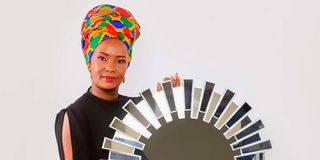Transform your home using decorative mirrors

Teresia Macharia is an interior designer and founder of Winners Home Collection.
Decorative mirrors are a classic and charming element of any home décor scheme.
By reflecting light and increasing the appearance of space, these adaptable pieces not only serve a practical purpose but also enhance a room's aesthetic appeal. They are available in a wide range of forms, sizes and styles to match any decor taste, from extravagant vintage-inspired designs to sleek contemporary pieces.
Mirrors have been used for a variety of purposes throughout history, including as decorative objects dating back thousands of years. Their use can be traced back to ancient Egypt, where polished metal and stone mirrors were used to create designs.
During the Middle Ages in Europe, mirrors were a luxury item and were often used as decorations in castles and palaces. Usually, they were encased in ornate frames and adorned with precious stones. During the Art Nouveau and Art Deco periods at the beginning of the 20th century, decorative mirrors became more sleek and modern, with simple geometric shapes and slim metal frames.
Today, they continue to gain popularity in our households.
“They have become a mainstay of home decor because they give a space aesthetic and practical value. Simply put, decorative mirrors are versatile pieces that can be used in many different ways to enhance the style and ambience of a room,” says Teresia Macharia, an interior designer and founder of Winners Home Collection. Teresia has been in the interior design industry for nearly 10 years and notes that this trend began to become popular in 2018 in the country and has been growing ever since.
“We import our decorative mirrors from China. The styles and designs that we stock are customised to complement any decor style, from traditional to modern and everything in between.”
Artistic value
She explains that the trend is popular due to the artistic value of the mirrors. Most of them are designed to be works of art in their own right, with intricate frames, unique shapes and ornate details.
They are also very flexible, which means they are easy to move and reposition. This makes it quick and easy to change how the room looks.
“Our prices range between Sh3, 500 and Sh30, 000 depending on the shape, size, style as well as the material used for finishing. Some may feature unique frames made from wood, metal or glass and may incorporate additional decorative elements such as etchings, carvings or embellishments,” she says.

By reflecting light and increasing the appearance of space, these adaptable pieces not only serve a practical purpose but also enhance a room's aesthetic appeal.
In general, decorative mirrors are relatively affordable, and this makes them an accessible and budget-friendly way to decorate a room.
The trend's popularity has also been boosted by social media, where bloggers and influencers show off how they use them in their homes, inspiring their fans and followers to do the same.
These design items are versatile and can be used in many different ways to add visual interest and enhance the style of a space. Depending on how they are set up, they can serve a practical purpose by reflecting light and creating the illusion of a larger space.
Silvia Koin, a decorative mirror lover and collector, believes that decorative mirrors, especially those with a touch of leather, add depth, character and elegance to a space, making it feel more inviting and polished.
“They add visual interest to a room, catching the eye and drawing attention to a particular space. I collect them because they are also mood enhancers. They create a calming and peaceful atmosphere, as well as provide a sense of warmth and comfort,” she notes.
On the best spaces to use them, Teresia says though they can be used in any room, most of her clients use them in the living room area and bathrooms, while others prefer having them in their bedrooms.
“I have had repeat clients who first buy pieces for their bathrooms—usually small sizes—then later buy bigger pieces for their living room areas and bathrooms,” she explains.
The mirrors are also often used in places such as hotels and restaurants to give off an air of sophistication and luxury. With so many options to choose from, homeowners and designers can find the perfect decorative mirror to complement any decor style. Another beauty of decorative mirrors is that due to their timeless and classic nature, they can be passed down through generations as heirloom pieces.
Much as decorative mirrors offer many benefits and are a popular choice in interior design, there are some potential disadvantages to consider as well. For example, they are fragile and can easily break or get damaged. As for maintenance, they need regular cleaning to keep them looking their best. The frames may also require touch-ups or repairs from time to time to keep them gleaming.
“Depending on the size and weight of the mirror, installation can be a challenge, particularly if the mirror needs to be mounted on a wall,” notes Teresia.
“Further, if not installed properly, they can pose a safety hazard, particularly if they are located in high-traffic areas or near children or pets, still, the advantages outweigh the downsides of decorative mirrors.”
From ancient Egypt to modern times, mirrors have been a big part of interior design and have been used both for function and decoration. Today, they come in a wide range of styles, shapes and sizes to match any kind of decor. Whether used as a focal point or as a subtle accent, decorative mirrors are a classic and elegant way to add visual interest and style to any space. So, if you haven’t yet, it is about time you got in trend and gave your space a new luxurious feel.





